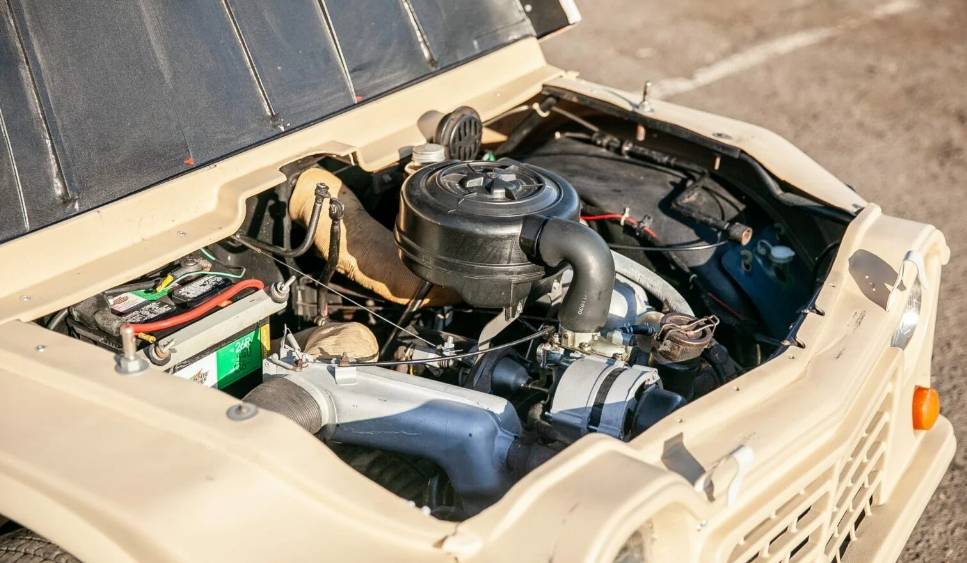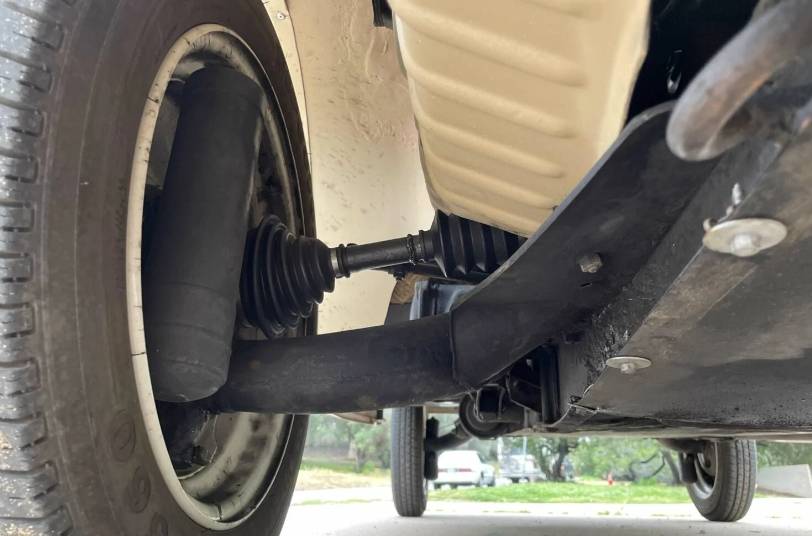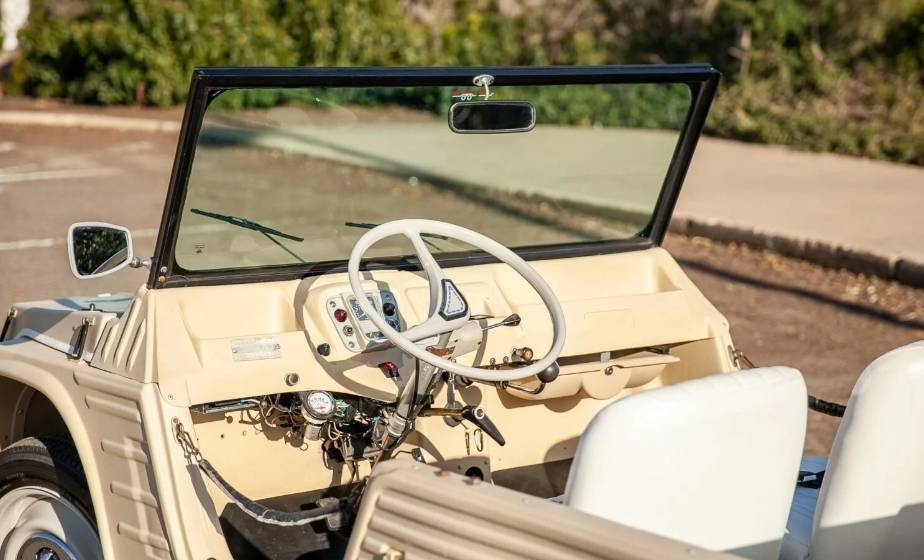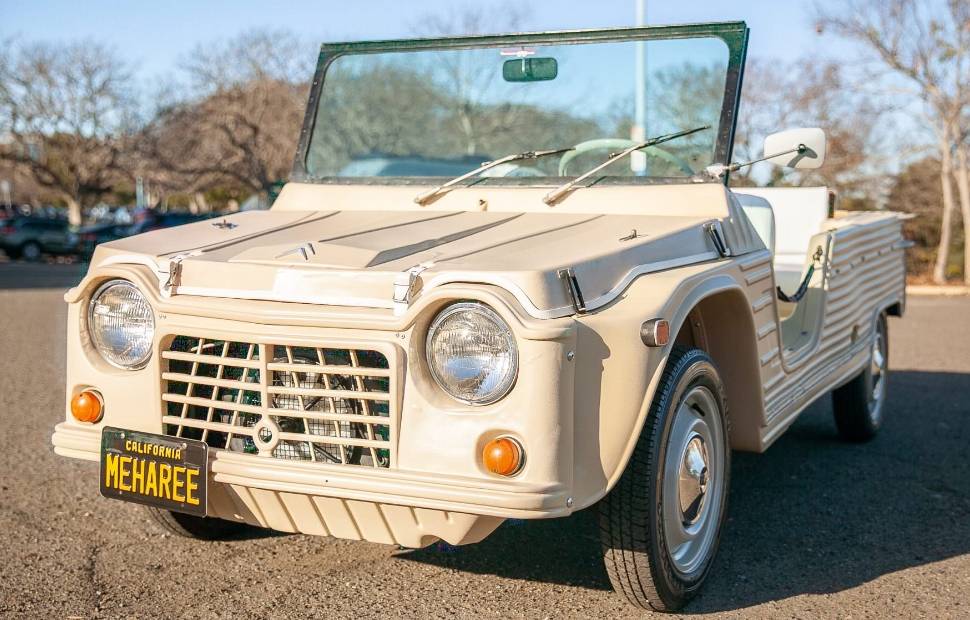The Méhari, with its unique ABS plastic body, proved to be a commercial success, with over 140,000 units sold during its 20-year production run. It found popularity as a beach resort vehicle in Europe, as well as a budget-friendly urban transport option. Additionally, the French Army purchased thousands of Méharis for various applications.
Fast Facts – The Citroën Méhari
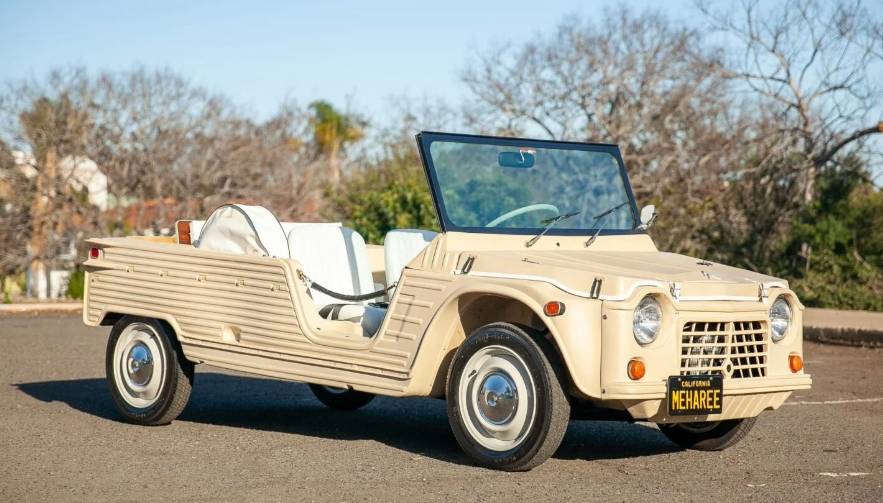
- The Citroën Méhari was the brainchild of Roland de La Poype, a former French fighter pilot and entrepreneur, who envisioned a cost-effective, versatile, and lightweight vehicle inspired by the iconic Mini Moke and the rugged Jeep used during World War II. Unveiled at the Paris Motor Show in 1968, the Méhari quickly captured the spotlight with its distinctive design and practicality.
- The Méhari utilized the chassis of the Citroën Dyane 6 and the mechanical components of the 2CV. What set it apart was its groundbreaking ABS plastic body, a brainchild of de La Poype. This pioneering material made the car remarkably lightweight, resistant to corrosion, and easy to maintain. The Méhari boasted a minimalist open body design, with removable doors, a foldable windshield, and a convertible soft-top roof, adding to its versatility and off-road prowess.
- In 1970, Citroën unveiled the Méhari 4×4 in response to the growing demand for a capable off-road vehicle. This variant featured four-wheel drive, making it ideal for various tasks such as patrolling, reconnaissance, and transportation of personnel and equipment. As a result, it gained popularity among the French military and other organizations that required a rugged and agile vehicle for their operations.
- The Méhari quickly gained popularity among civilians, especially in beach communities and rural areas, thanks to its adaptability and low-maintenance nature. It was embraced as a leisure and utility vehicle, known for its association with fun and adventure. The Méhari became a symbol of carefree, outdoor living, and its quirky design and simple functionality captured the hearts of many.
- The Citroën Méhari had a production span of two decades, during which over 140,000 units were manufactured. While its main market was in Europe, the car also made its way to various international markets, including a short period of importation into the United States between 1969 and 1970.
The Car With A Plastic Body
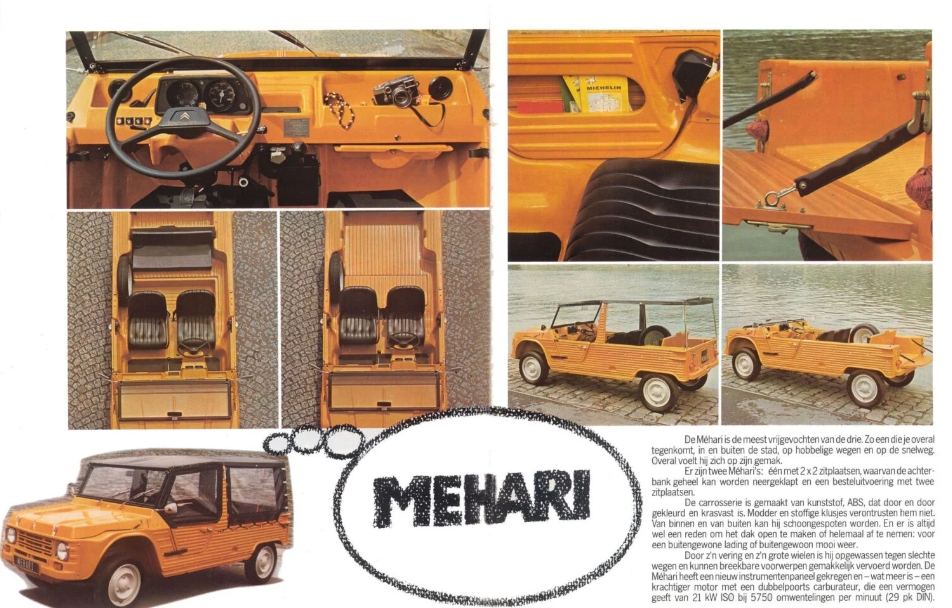
The tale of the Méhari originates with its innovator, Count Roland de la Poype, a renowned French World War II fighter ace and industrialist. Following the war, de la Poype delved into plastics and established the Société d’Etudes et d’Applications des Plastiques (SEAP). Drawing inspiration from the popularity of the Mini Moke, a lightweight utility vehicle, de la Poype set out to create a similar car featuring a lightweight body made of ABS plastic.
De la Poype’s vision was to demonstrate the potential of mass-produced plastic-bodied cars in the automotive industry. While he admired the Mini Moke, he identified two major limitations: limited ground clearance and a steel unibody shell susceptible to rust. He aimed to address these issues with the Méhari by utilizing ABS plastic for its body, offering improved ground clearance and corrosion resistance.
The Méhari addressed both of these concerns by providing increased ground clearance, improved suspension, and a distinctive ABS plastic body with corrugated sides, a fold-down windshield, and a beach-friendly hop-in/hop-out open layout. This innovative design not only offered better off-road capabilities but also added to the car’s unique charm and functionality.
- The name “Méhari” was inspired by the dromedary camel, known for its speed, endurance, and agility. The car made its debut at the Paris Motor Show in October 1968, capturing attention with its distinctive design, durability, and versatility. Its unique features and capabilities quickly gained popularity among automotive enthusiasts and adventure seekers alike.
The Citroën Méhari
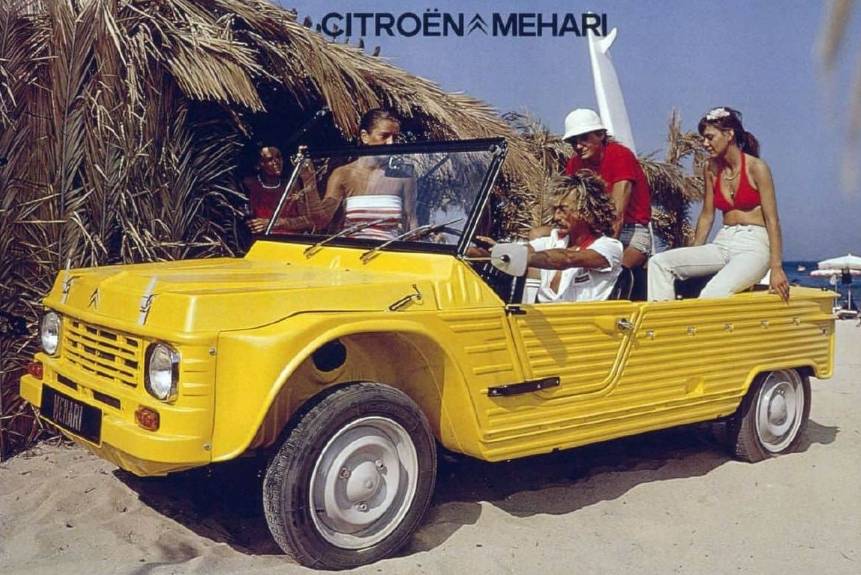
The ABS plastic body of the Citroën Méhari was truly remarkable. It was crafted entirely from Acrylonitrile Butadiene Styrene, a lightweight material that was not susceptible to rust. Additionally, the plastic body offered a degree of flexibility, making the car highly adaptable to diverse conditions. This unique construction contributed to the Méhari’s durability, versatility, and low maintenance requirements, setting it apart from traditional vehicles of its time.
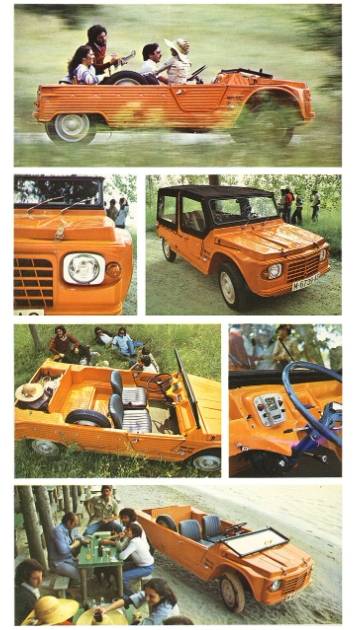
The Méhari’s body was available in a plethora of vibrant colors, which added to its distinctive appearance and appealed to the fashionable French youth of the 1960s and beyond. The eye-catching hues of the ABS plastic body further enhanced the car’s unique charm and made it a standout on the roads. The Méhari was not just a vehicle, but also a fashion statement that exuded style and individuality, making it a beloved choice among the trendsetters of its time.
The Méhari was built using the chassis of the Citroën Dyane 6 and shared many mechanical components with the Citroën 2CV, including the front-wheel-drive layout and the air-cooled, 602cc flat-twin engine that powered the front wheels. Despite its simple design, the Méhari boasted a surprisingly capable suspension system that enabled impressive off-road capabilities. Its lightweight body and low center of gravity contributed to its agility and performance on rough terrains. In case of getting stuck, the Méhari’s light weight made it easy for two or more people to simply push it out. The combination of its front-wheel-drive layout, robust suspension, and lightweight construction made the Méhari a go-anywhere vehicle that was versatile and fun to drive, both on and off the road.
The Citroën Méhari’s lightweight body, weighing only 570 kgs (or 1,256 lbs), set it apart and made it comparable in weight to the steel-bodied Willys MB Jeep, which weighed 1,113 kgs (or 2,453 lbs). This lightweight design, combined with its adaptable features, made the Méhari a versatile vehicle that found popularity in both civilian and military applications.
The open-air cabin and fold-down windshield of the Méhari made it a perfect choice as a beach buggy, offering a spacious and enjoyable driving experience. Additionally, its robust construction and off-road capabilities caught the attention of the military, making it suitable for various tasks such as patrolling, reconnaissance, and transportation of personnel and equipment.
The Arrival Of The Citroën Méhari 4×4
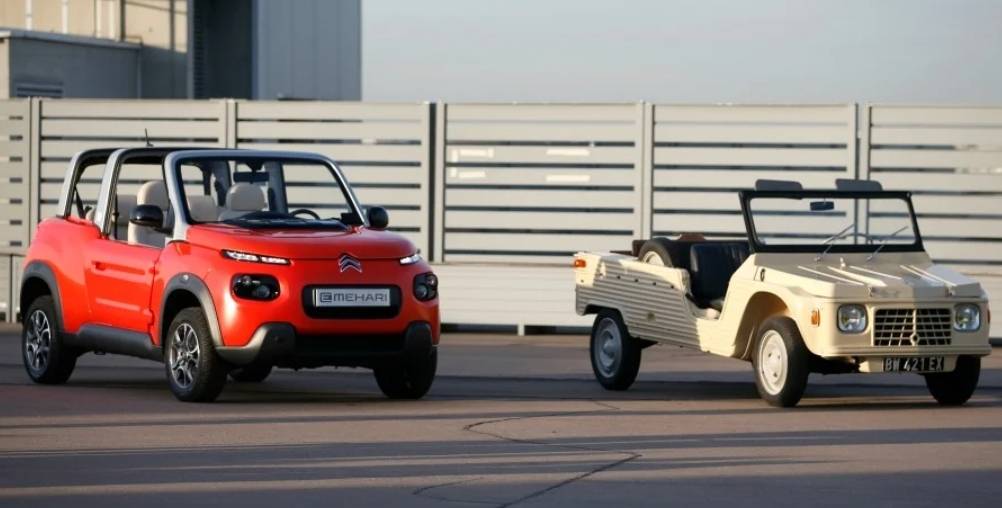
In 1979, Citroën expanded the Méhari lineup by introducing the Méhari 4×4, which boasted a four-wheel-drive system and a lockable rear differential, elevating its off-road capabilities to a new level. Unlike the Citroën 2CV 4×4, which utilized engines at both ends to power the front and rear wheels separately, the Méhari 4×4 featured a single front-mounted engine that powered all four wheels, offering improved traction and versatility in challenging terrains.
The Méhari continued to roll off the production line until 1987, with a total production of over 144,000 units. Although it was eventually discontinued, the Méhari has maintained a devoted following among enthusiasts, and preserved examples are highly coveted in the collector’s market. Its unique design, iconic status, and versatile capabilities have made it a sought-after classic vehicle, cherished by those who appreciate its distinct charm and enduring appeal.
Citroën paid homage to the iconic Méhari in 2016 with the introduction of the E-Méhari, a contemporary electric version that captured the essence of the original while incorporating a modern 100% electric powertrain. This updated iteration honored the Méhari’s legacy of innovation and adaptability, while also embracing the latest advancements in electric mobility, showcasing Citroën’s commitment to sustainability and cutting-edge automotive technology.
The 1970 Citroën Méhari Shown Here
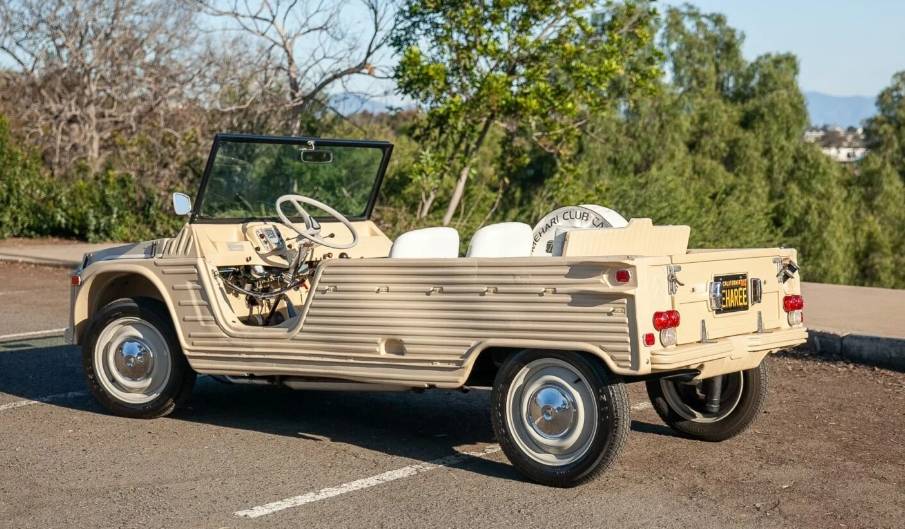
The vehicle presented here is a US-market Méhari that has recently undergone a comprehensive refurbishment. The body has been expertly repaired and repainted in a tan hue, while the seats have been retrimmed in white vinyl, lending a fresh and pristine appearance. Additionally, the engine has been meticulously rebuilt, ensuring reliable performance for many years to come. This refurbishment exemplifies the car’s enduring appeal and commitment to quality, making it ready for many more years of enjoyable use.
The Méhari is equipped with authentic 15″ wheels, reflecting the period-correct aesthetic. Other notable features include sealed beam headlights, front lap belts for added safety, practical rubber floor mats for easy maintenance, and a spare tire with a matching cover made from the same material as the seats. These details contribute to the overall authenticity and charm of this classic vehicle, showcasing its attention to detail and timeless appeal.
This Méhari is currently available for purchase in San Diego, California, and comes complete with original manufacturer’s literature, workshop manuals, spare parts, a car cover, and personalized black California license plates that read “Meharee”. Additionally, the seller holds a clean California title in their name, ensuring a smooth and hassle-free transaction for the buyer. This comprehensive package offers an excellent opportunity for enthusiasts to own a piece of automotive history with all the necessary documentation and accessories for a truly authentic ownership experience.
